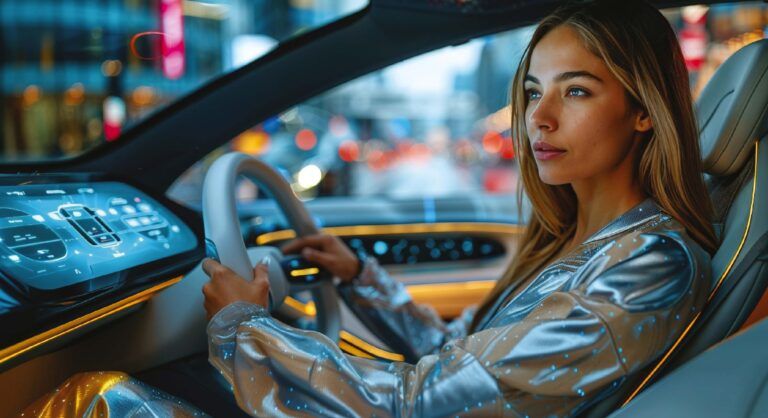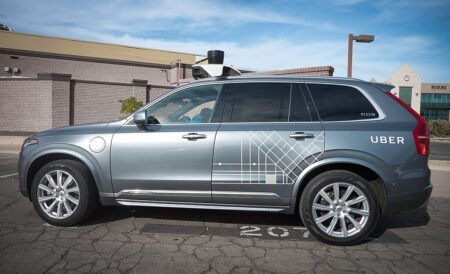As the powers of AI perception and analysis increase, so the ways in which automated vehicle (AV) systems are being developed are changing, impacting both driver assistance systems and autonomy at Level 3 and beyond
The growing capabilities of artificial intelligence are leading some companies to focus on achieving full Level 4 or 5 autonomy as quickly as possible, while others are using AI to refine lower levels of automation, otherwise termed advanced driver assistance systems (ADAS).
Two companies that embody these two differing approaches are Imagry, which is pursuing full vehicle autonomy without relying on HD maps, and Nauto, which is using the power of AI recognition to enhance the perception of human drivers and therefore improve safety for vehicles on the road today.
Dr Stefan Heck, whose background spans neural networks, deep learning, and management consulting, founded Nauto with a comprehensive vision of urban mobility. “How do you really make vehicles safer, more equitable, more accessible, more convenient and more efficient?” he asks. This holistic approach led to a pragmatic solution: enhance human drivers rather than replace them.
“Our philosophy was, let’s support humans first, and then let’s gradually increase the degree of autonomy,” says Heck. This strategy emerged from his assessment of current autonomous technology limitations. Heck believes that while autonomous vehicles show promise in specific scenarios, they’re not yet ready for universal deployment.

Nauto’s system works using a video sensor package installed on a vehicle’s windshield that uses edge AI analysis to monitor both the road ahead and the driver’s behavior. The system processes this dual-stream data to look “four or five seconds into the future” and identify rising risk levels, so it can provide warnings to drivers before crashes happen.
“On average, we are looking at about 65% crash reduction, but our best case is 90%,” says Heck. These results equal safety improvements promised by fully autonomous vehicles, which typically claim accident reductions in the mid-90% range. The difference is Nauto’s system can be deployed today, across existing vehicle fleets, without geographical restrictions.
Initially developed as a retrofit solution, it is now also being integrated by major OEMs lik GM and Stellantis, its success driven by a compelling business case. For commercial fleet vehicles operating daily losses from crashes typically run to about $5,000 per vehicle per year. For a fleet of 1,000 vehicles this would be $5m. With a retrofit cost of just a few hundred dollars plus a subscription fee, the return on investment becomes obvious. Heck states that the Nauto system can reduce outlay by around two-thirds.
Driver alerts are graduated, starting with subtle audio cues for minor issues, progressing to voice coaching for riskier behavior, and culminating in urgent alarms for imminent dangers. “We’ve designed this very critical intervention scheme,” Heck explains. “It starts very subtle… Nobody likes somebody really chatty in the car with them!”
The Nauto system monitors for 30 different risk factors, from stop signs and red lights to driver fatigue and mobile phone use and is effective at identifying compound risks. While frequent hard braking might make a driving 40% riskier, using a phone while driving increases risk by 900%. “If I’m texting and there’s a pedestrian crossing, now it’s 2,500 times riskier,” Heck notes. “Texting while there are people crossing or vehicles braking is just lethal. So, you really want to avoid that.”
Full autonomy
On the other end of the automation spectrum, Imagry is a company developing a system that enables full autonomous driving. But while its aims are different from Nauto’s, there is a key similarity in that both are harnessing the growing power of AI and relying on edge processing rather than cloud connectivity, enabling full functionality whatever the communications coverage. “If you’re going through a tunnel or you’re in a parking garage, you still want the AI to work,” says Heck.
“Unlike many other players in the market, we don’t use HD maps”
Imagry CEO Eran Ofir
Imagry refers to its system as mapless autonomous driving. “Unlike many other players in the market, we don’t use HD maps,” says Imagry CEO Eran Ofir. This distinction is crucial – Imagry’s system instead builds its understanding of the environment in real-time, much like a human driver.
Also like Nauto, Imagry’s system is video-based, using eight cameras and an array of neural networks, each responsible for different aspects of perception: traffic lights, signs, pedestrians, lanes, and vehicles. “We build layers in real time, a three-dimensional map that represents everything surrounding the vehicle – 360 degrees and 300 meters ahead,” says Ofir.
This approach offers advantages over map-based systems when dealing with the unexpected. Work zones, temporary traffic signs, or sudden changes in the environment can be processed and responded to immediately, without waiting for map updates.

Reducing the level of connectivity in its system also helps Imagry to comply with the new Cyber Framework (UNR 155), which is becoming mandatory across Europe to protect vehicles form cyberattacks. “Think about the bus full of passengers that is relying on external communication that will tell it where to drive. That’s a big problem,” says Ofir.
Another of Imagry’s key differentiators is its hardware-agnostic nature. “Our software is not tightly coupled to a specific hardware, like most of the players in the market,” says Ofir. This flexibility allows the system to be deployed across different vehicle types and price points, a crucial advantage when working with various OEMs and fleet operators.
Future opportunities
Both companies see public sector transportation as a key early application for their technologies, albeit for different reasons. Nauto has found particular success with public sector fleets, including police cars, street sweepers, and garbage trucks. These vehicles present unique challenges: police officers often need to check license plates while driving, while street sweepers navigate complex patterns around parked cars.
Imagry meanwhile sees autonomous buses as a likely first step toward widespread autonomy. “Autonomous buses are going to be here, probably before the mass production of Level 3 autonomous passenger vehicles,” says Ofir. He cites several advantages: lower speeds, fixed routes, and controlled environments make buses an ideal testing ground for full autonomy.
As the autonomous vehicle industry matures, both approaches may find their place in our transportation future. Nauto’s technology offers immediate safety benefits f or existing vehicles and fleets, while Imagry’s map-free autonomous system points toward a future of truly independent selfdriving vehicles.
The convergence point is their shared belief in the power of AI and real-time perception. Whether enhancing human drivers or replacing them entirely, both companies demonstrate how artificial intelligence can make our roads safer – one vehicle at a time.
WHERE NOW FOR ROBOTAXIS?

The race to develop and deploy autonomous robotaxis has seen dramatic shifts in recent months, with major players like General Motors’ Cruise and Hyundai-backed Motional reconsidering their strategies.
After investing more than $10 billion in its autonomous taxi subsidiary Cruise, General Motors (GM) announced in December 2024 it was to absorb the business into its main product line and focus instead on developing ADAS for private cars – a system it calls Super Cruise.
“Las Vegas was the first to implement an autonomous vehicle in free-flowing traffic. We had the largest AV fleet learning how to maneuver in a complex environment”
MJ Maynard, CEO, RTC Southern Nevada
Earlier in 2024 another major player in the space, Motional, which was piloting robotaxis in Las Vegas in partnership with Uber and Lyft, scaled back its ambitions, with CEO Karl Iagnemma emphasizing that driverless deployment “will not happen overnight.”
Nevertheless MJ Maynard, CEO of the Regional Transportation Commission (RTC) of Southern Nevada, which oversaw the Vegas pilot, highlights the significance of the city’s role in AV development. “Las Vegas was the first to implement an autonomous vehicle in free-flowing traffic,” she tells TTi. “We had the largest fleet of autonomous vehicles learning how to maneuver in a highly complex environment.”
Companies like Alphabet’s Waymo and Amazon’s Zoox continue to push forward with robotaxis, but their long-term success hinges on proving that autonomous fleets can be not only many times safer than human drivers but also financially sustainable.
“You might hear about autonomous vehicles and think, ‘I would never get in one,’” says Maynard. “But when you see it, touch it, and ride in it, it takes away the fear. That bodes well for the future.”
Podcast Extra
Listen to interviews with Eran Ofir, Dr Stefan Heck and MJ Maynard on TTi’s Transportation Podcast
Levels of automation
The Society of Automotive Engineers (SAE) defines the levels of autonomous driving on a scale from 0 to 5, with 0 being fully manual and 5 being fully autonomous
• Level 0: No automation, the driver controls the car
• Level 1: Driver assistance, automated control of either speed or steering, such as cruise control or automated parking
• Level 2: Partial automation, automated control of speed and steering in certain situations, such as dynamic cruise control with lane-keeping assistance
• Level 3: Conditional automation, where the vehicle can temporarily take over
• Level 4: High automation, where the vehicle can operate autonomously and bring itself safely to a stop if the driver does not take over control in case of a problem.
• Level 5: Full automation, where the vehicle can perform any driving teask, removing the need for a steering wheel and pedals
This feature was first published in the March 2025 edition of TTi magazine



 “Unlike many other players in the market, we don’t use HD maps”
“Unlike many other players in the market, we don’t use HD maps” “Las Vegas was the first to implement an autonomous vehicle in free-flowing traffic. We had the largest AV fleet learning how to maneuver in a complex environment”
“Las Vegas was the first to implement an autonomous vehicle in free-flowing traffic. We had the largest AV fleet learning how to maneuver in a complex environment”

